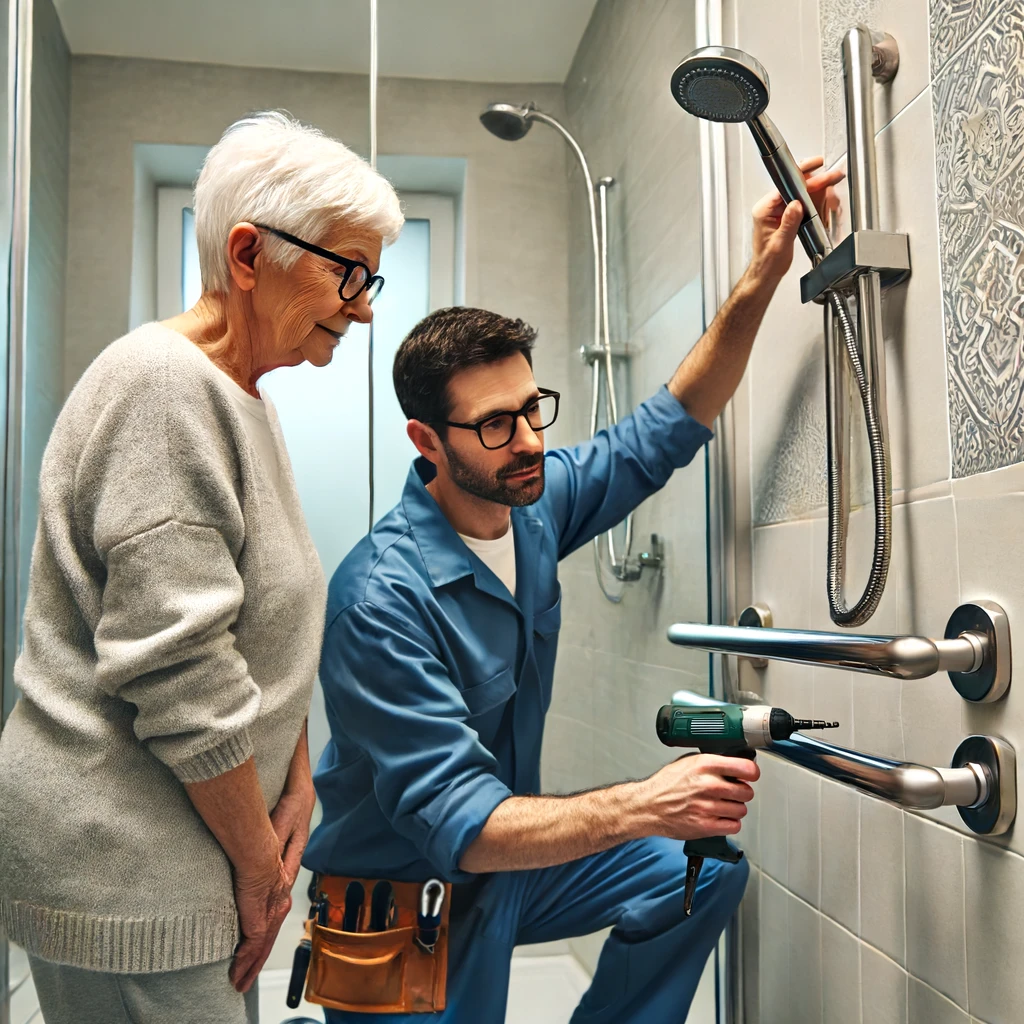**Disclosure:** We believe in honesty and transparency to the fullest extent. Some of the links on this blog are affiliate links, meaning, at no additional cost to you, we will earn a commission if you click through and make a purchase. This is one of the simplest ways you can support us.

As the population ages, the need for homes that accommodate the elderly and those with disabilities is growing rapidly. Accessibility remodeling is a niche business that focuses on modifying homes to make them safer and more comfortable for people with mobility issues, sensory impairments, or other age-related challenges. This type of remodeling not only enhances the quality of life for many individuals but also presents a lucrative opportunity for entrepreneurs. With the aging baby boomer generation and an increasing awareness of the importance of inclusive design, the demand for accessibility modifications is set to rise significantly in the coming years.
One of the primary factors driving this demand is the desire of many seniors to age in place. Unlike previous generations, today’s elderly population is more inclined to stay in their own homes rather than move to senior living facilities. According to a 2018 AARP survey, nearly 76% of Americans aged 50 and older prefer to remain in their current homes as they age. Aging in place allows them to maintain their independence, stay in familiar surroundings, and avoid the high costs associated with assisted living homes. As a result, there is a growing market for home modifications that can adapt existing living spaces to meet the evolving needs of older adults.
A 2019 report from the Harvard Joint Center for Housing Studies found that more than half of U.S. households have at least one person with a disability, and the majority of these households do not have the necessary modifications to accommodate mobility issues. This gap presents a significant opportunity for accessibility remodeling businesses.1
Market Analysis

Demographic Trends
The demographic landscape is shifting as the global population ages. In the United States, the number of people aged 65 and older is projected to nearly double from 52 million in 2018 to 95 million by 2060, according to the U.S. Census Bureau. This significant increase highlights a growing market for services and products tailored to the needs of the elderly. Additionally, many seniors prefer to age in place, staying in their own homes rather than moving to assisted living facilities. This preference further drives the demand for home modifications that can accommodate their changing needs.
Increasing Demand for Age-Friendly Homes
With the aging population comes an increasing demand for homes that are safe, comfortable, and accessible. Features such as wider doorways, ramp installations, grab bars, and stairlifts are becoming essential components of age-friendly homes. The trend towards multi-generational living also contributes to the need for accessible modifications, as families prepare their homes to accommodate aging parents or grandparents.
Government Incentives and Grants
Governments are recognizing the importance of supporting the aging population and are offering various incentives and grants to encourage accessibility remodeling. These programs can significantly offset the cost of modifications for homeowners and make it more affordable for them to adapt their homes. For entrepreneurs, these incentives can be a valuable selling point when marketing their services. Knowing the available funding options and helping clients navigate these resources can set a business apart from its competitors.
Business Opportunities

Types of Accessibility Remodeling Services
The scope of accessibility remodeling is broad, encompassing a range of services designed to enhance mobility, safety, and comfort. Common modifications include:
- Ramps and Elevators: Installing ramps or home elevators to provide easy access to different levels of the home.
- Grab Bars and Handrails: Adding grab bars in bathrooms, hallways, and stairways to prevent falls.
- Accessible Bathrooms: Remodeling bathrooms to include walk-in tubs, roll-in showers, and adjustable-height sinks and toilets.
- Wider Doorways and Hallways: Expanding doorways and hallways to accommodate wheelchairs and walkers.
- Stairlifts: Installing stairlifts for those who have difficulty navigating stairs.
- Smart Home Technology: Incorporating smart home features such as voice-activated lighting and thermostats to enhance convenience and safety.
Specialized Services
In addition to standard modifications, there are opportunities to offer specialized services that cater to specific needs. These might include:
- Fall Prevention Modifications: Installing non-slip flooring, improving lighting, and eliminating trip hazards.
- Home Automation: Integrating home automation systems that allow seniors to control various aspects of their home environment through smartphones or voice commands.
- Universal Design: Implementing universal design principles to create spaces that are accessible to people of all ages and abilities.
Potential Clients
The potential client base for accessibility remodeling is diverse and includes:
- Elderly Individuals: Seniors looking to modify their homes to age in place.
- Families with Aging Members: Families preparing their homes to accommodate elderly relatives.
- Healthcare Facilities: Assisted living centers, nursing homes, and rehabilitation facilities that require accessibility upgrades.
- Builders and Developers: Professionals in the construction industry looking to incorporate accessible features into new builds or renovations.
By targeting these various client groups, businesses can tap into a steady stream of demand and establish themselves as leaders in the accessibility remodeling market.
Profitability and Financial Considerations
Cost of Starting an Accessibility Remodeling Business
Starting an accessibility remodeling business requires an initial investment in tools, materials, training, and marketing. Typical startup costs might include:
- Tools and Equipment: Basic construction tools (e.g., drills, saws, measuring tools) and specialized equipment for installing ramps, lifts, and smart home technology.
- Materials: High-quality, durable materials suitable for accessibility modifications, such as non-slip flooring, grab bars, and adjustable fixtures.
- Training and Certification: Professional training courses and certifications in accessibility standards and remodeling techniques.
- Licensing and Insurance: Business licenses, liability insurance, and workers’ compensation insurance to protect your business and employees.
- Marketing: Developing a website, advertising, and networking with local healthcare providers and community organizations.
The total initial investment can range from $1,000 to $50,000, depending on the scale of your operations and the specific services you offer.
Potential Revenue Streams and Profit Margins
Accessibility remodeling offers various revenue streams, including:
- Home Modifications: Revenue from installing ramps, grab bars, stairlifts, and other accessibility features.
- Smart Home Integrations: Additional income from integrating smart home technology tailored to seniors’ needs.
- Consulting Services: Fees for consulting with homeowners on the best modifications for their specific needs.
- Maintenance Contracts: Ongoing revenue from maintenance and repair services for installed accessibility features.
Profit margins in this niche can be quite favorable due to the specialized nature of the work and the willingness of clients to invest in high-quality, safe modifications. According to industry data, profit margins for remodeling businesses can range from 15% to 40%, with accessibility remodeling often on the higher end due to the added value of specialized services.
Examples of Simple Accessibility Modifications and Their Potential Price Points
1. Installing Grab Bars
Grab bars are essential safety features that can be installed in bathrooms and other areas to provide support and prevent falls.
- Installation Cost: The cost to install a grab bar ranges from $80 to $200 per bar, including materials and labor.
- Materials: Grab bars themselves cost between $20 and $100, depending on the quality and design.
- Labor: Professional installation typically costs between $60 and $100 per hour.
2. Non-Slip Flooring
Replacing existing flooring with non-slip materials can significantly reduce the risk of falls, especially in bathrooms and kitchens.
- Installation Cost: The cost to install non-slip flooring varies widely based on the material chosen, ranging from $3 to $15 per square foot, including materials and labor.
- Materials: Non-slip vinyl or rubber flooring costs between $2 and $10 per square foot.
- Labor: Professional installation costs range from $1 to $5 per square foot.
3. Lever Door Handles
Replacing traditional door knobs with lever-style handles makes it easier for individuals with arthritis or limited hand strength to open doors.
- Installation Cost: The cost to replace door knobs with lever handles ranges from $50 to $150 per handle, including materials and labor.
- Materials: Lever handles cost between $20 and $50 each.
- Labor: Professional installation costs around $30 to $100 per hour, depending on the complexity and number of handles being replaced.
Case Studies and Examples of Successful Businesses
Several businesses have successfully tapped into the accessibility remodeling market:
- Handi-Ramp: A company specializing in custom ramps and lifts, which has grown by addressing the unique needs of the aging and disabled population.
- Lifeway Mobility: Offers a range of home accessibility solutions, including stairlifts, ramps, and transfer aids, demonstrating strong market demand and profitability.
These examples illustrate the potential for growth and profitability in the accessibility remodeling sector.
Conclusion

The niche business of accessibility remodeling presents a significant opportunity for aspiring entrepreneurs. As the population ages and more seniors express a preference for aging in place, the demand for home modifications that enhance safety and comfort is set to increase. By offering services such as installing grab bars, non-slip flooring, and lever door handles, businesses can address a crucial need and tap into a growing market.
The profitability of this sector is bolstered by favorable demographics, government incentives, and a high potential for return on investment. With thoughtful market analysis, effective marketing strategies, and a focus on quality and customer satisfaction, entrepreneurs can build successful businesses that not only generate substantial revenue but also make a meaningful impact on the lives of their clients.
Aspiring entrepreneurs should seize this opportunity to enter the accessibility remodeling market, leveraging the growing demand and making a positive difference in their communities. By doing so, they can contribute to creating safer, more comfortable living environments for seniors and those with disabilities, while also achieving financial success.










